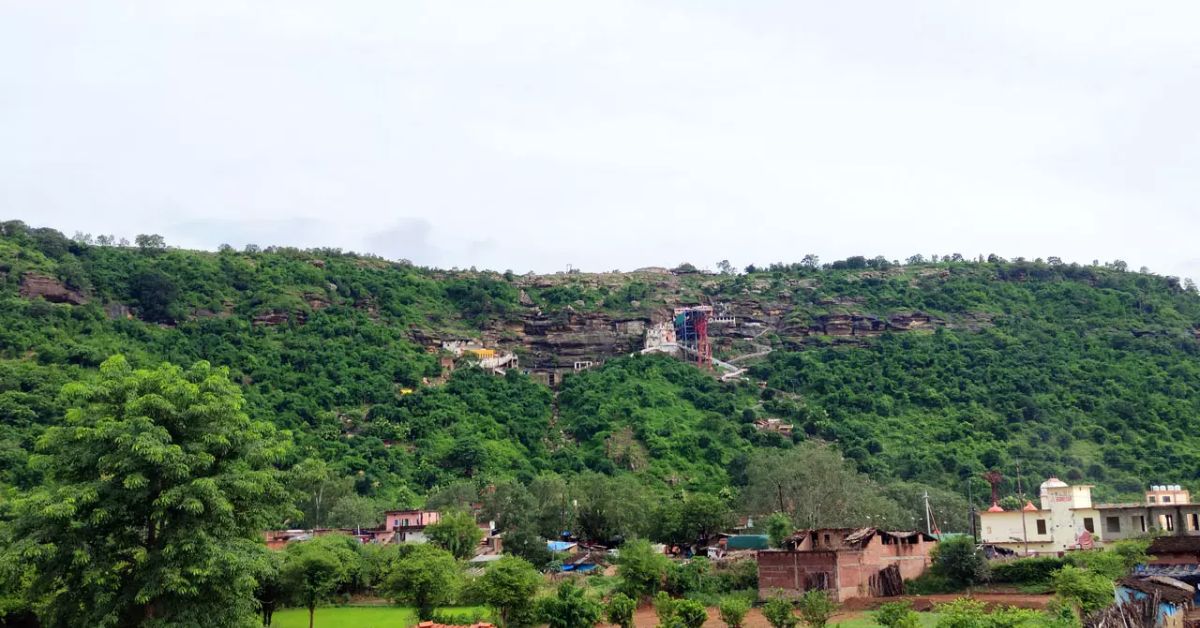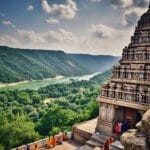Experience the sacred Kamadgiri Parikrama in Chitrakoot — a spiritual walk around the revered hill, steeped in mythology and divine significance. A must-do for devotees.
In the deeply spiritual heartland of Chitrakoot, nestled within the serene folds of Madhya Pradesh and Uttar Pradesh, lies the sacred hill of Kamadgiri. Revered as the very center of divine presence in the region, Kamadgiri means “the hill that fulfills desires.” Pilgrims from across India and beyond undertake the Kamadgiri Parikrama, a ritual circumambulation of the hill, seeking blessings, peace, and the fulfillment of their deepest wishes.
This divine walk around the hill is not just a physical journey but a profound spiritual experience, imbued with mythological significance, ancient temples, and the echo of sacred chants.

The Divine Significance of Kamadgiri Hill
Kamadgiri is considered to be the original Chitrakoot, the place where Lord Ram, Sita, and Lakshman spent 11 of their 14 years in exile. According to the Ramayana and various Puranic texts, this forest-clad hill was sanctified by their divine presence and became a haven for sages, saints, and seekers. The hill is believed to be the embodiment of Lord Rama himself, and thus, performing a Parikrama of Kamadgiri is equivalent to circumambulating the Lord.
Kamadgiri Parikrama Route: A Sacred Journey
The Parikrama path around Kamadgiri is approximately 5 kilometers long, encompassing a circular path that wraps around the sacred hill. The entire route is paved with stone and lined with ancient temples, shrines, ashrams, and sacred water bodies. Devotees walk barefoot, chanting “Jai Shri Ram”, in deep devotion.
Key Highlights Along the Parikrama Route:
1. Bharat Milap Temple
The sacred spot where Bharat met Lord Ram, urging him to return to Ayodhya. It is one of the most emotionally charged locations on the Parikrama route.
2. Charan Paduka
This temple enshrines the imprints of Lord Ram’s feet, worshipped by devotees as a physical reminder of his presence.
3. Sphatik Shila
A gleaming crystal rock where Lord Ram and Sita are said to have rested. Surrounded by dense trees, it emanates a peaceful and meditative aura.
4. Hanuman Dhara Path Junction
From the Parikrama, a diversion leads to Hanuman Dhara, a famous waterfall where Lord Hanuman was cooled after burning Lanka. Though not part of the main Parikrama, it’s often visited together.
5. Numerous Small Shrines
The entire path is peppered with miniature temples dedicated to Lord Ram, Hanuman, Lakshman, Sita, and various sages. Pilgrims often pause to offer prayers at each.
Performing the Parikrama: Rituals and Practices
Time to Walk:
Most pilgrims prefer to start the Parikrama early in the morning, just after sunrise, when the air is cool, and the spiritual vibrations are at their peak. Evening Parikramas are also common, especially under the full moon.
Barefoot Walk:
It is customary to walk barefoot as a mark of humility and devotion. The stone pathway is smooth and well-maintained.
Chanting and Meditation:
Throughout the Parikrama, devotees chant mantras, recite Ramayana verses, or walk in silence, reflecting on the divine.
Offerings:
Small offerings of flowers, rice, incense, and lamps are made at the temples along the way. Many also offer diya floats at Ram Ghat after completing the Parikrama.
Religious Beliefs & Miracles Associated with Kamadgiri
Many pilgrims believe that prayers made during Kamadgiri Parikrama are always answered. Whether seeking health, harmony, success, or salvation, this sacred walk is seen as a direct channel to Lord Ram’s grace.
Countless stories circulate about miraculous healings, fulfilled desires, and spiritual awakenings experienced by those who completed the Parikrama with sincerity.
Festivals During Which Parikrama is Most Auspicious
The birthday of Lord Ram sees thousands of devotees performing the Parikrama in celebration and gratitude.
2. Amavasya (New Moon) and Poornima (Full Moon)
These lunar days are considered highly auspicious for the completion of rituals and Parikrama.
Nine-night festivals of divine feminine energy during which pilgrims fast, pray, and walk the Parikrama for blessings.
Facilities for Pilgrims
- Drinking water kiosks are set up at intervals along the route
- Benches and shaded areas offer rest stops
- Cleanliness is well maintained, with regular sweeping and support from volunteers
- Shoe-keeping counters and locker facilities available at Ramghat, the starting point
Tips for a Smooth Kamadgiri Parikrama Experience
- Start early to avoid heat and crowd
- Carry a water bottle, though there are stops along the way
- Respect temple customs, remove footwear, and dress modestly
- Maintain silence or chant softly, creating a peaceful environment for all pilgrims
- Avoid littering—keep the holy site clean
Where to Stay Near Kamadgiri
Chitrakoot offers several ashrams, dharamshalas, and budget-friendly hotels close to the Kamadgiri temple complex. Popular choices include:
- Ramayana Bhavan Ashram
- UPSTDC Tourist Bungalow
- Bharat Milap Dharamshala
- Sita Rasoi Guest House
These accommodations are simple, spiritual, and provide access to vegetarian, sattvic meals.
How to Reach Kamadgiri Hill in Chitrakoot
- By Road: Well-connected by road from Prayagraj (130 km), Varanasi (240 km), and Lucknow (230 km).
- By Train: Nearest station is Chitrakoot Dham Karwi Railway Station, about 11 km away.
- By Air: Closest airports are in Prayagraj and Khajuraho.
Auto rickshaws and shared taxis are easily available from Chitrakoot town to Kamadgiri.
Conclusion: A Journey of Devotion, One Step at a Time
Kamadgiri Parikrama is more than a sacred walk—it is a transformational journey where every step takes you closer to Lord Ram’s divine essence. As you walk along the age-old path surrounded by timeless temples, echoing chants, and natural serenity, the boundaries between myth and reality blur. This is a place where the Ramayana comes alive, not in stories, but in every stone and prayer that lines the hill.
Let the path purify your heart, let the mantras guide your soul, and let the sacred hill of Kamadgiri fulfill the unspoken wishes buried deep within.





